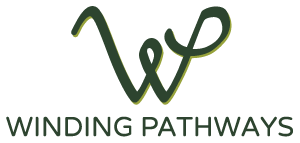by Winding Pathways | Feb 15, 2024 | Preparedness
We were starting to pack for a winter trip to visit our Alaskan daughter when she called. “Bring gaiters along with your snowshoes,” she said. That sparked a lively conversation between us and piqued our curiosity.
Marion calls the item of clothing that keeps snow and dirt from getting into boots gaiters. Rich calls them spats. Who’s right? Well, we both are. Gaiters, spats, puttees, chaps, and leg warmers all are designed to protect legs, ankles, or feet from snow, dirt, or the cold. Some add a flair of fashion to their role of protection and they can be mostly decorative.
Gaiters
Gaiters are modern and popular with winter outdoor enthusiasts. Usually made of nylon or another synthetic fabric, they fasten over pant legs and shoes to keep grime and snow out. Unless a skier or snowshoer likes cold wet feet, gaiters are essential. Some gaiters have a chemical coating that helps protect from ticks, too.
-

-
Ways to protect feet and legs.
-

-
Long or short it is up to you.
Spats
Spats go way back. Rich remembers his Army days when soldiers wore bright white spats during formal ceremonies and parades. Spats is a shortened word for spatterdashes. Military ones were made of white canvas and may still be. Spats are usually short and worn over the lower trouser legs and shoes. Back a century ago stylish men and women often wore fancy spats on dress-up occasions. Today heavy-duty spats are made for protection, rather than fashion, and are worn by welders and construction workers to protect their feet and ankles from sparks and heavy falling objects.
Puttees
Pity the poor World War I soldiers who had to live in filthy, muddy trenches. Often, they wore puttees in an attempt to keep cold, grimy slime out of their shoes and off their lower legs. The Canadian War Museum explains that a puttee is a length of, usually, cotton material, somewhat like a bandage roll, that was wound around the ankle, lower pants legs, and upper parts of shoes. They were likely no match for a trench’s muck. Puttees are hardly ever used today and the name is nearly lost.
Leg Warmers
Leg Warmers emerged from a dancewear shop in the East Village. Designed to keep dancers’ legs and feet warm, they because fashion accessories. The 1983 movie Flashdance and Jane Fonda with her workout videos helped popularize these practical, stylish accessories throughout the ‘80s. They’re long tubes of colorful warm fabric that fit tightly over much of the legs. They haven’t gone away. Usually, they’re worn by women.
Chaps
Chaps are still another clothing item that are worn over the legs for protection. Cowboys wore them to fend off thorns. Loggers use them to protect their legs from wayward sharp chainsaw teeth. Rich spent a season logging in Idaho, where they were spelled chaps but pronounced shaps. Idaho’s unusual. In most other places people use the “c” sound. Chainsaw chaps have the amazing ability to stop a speeding chain’s teeth before tearing into the operator’s legs. They’re strictly for protection and anyone running a chainsaw is wise to wear them.
So, are they gaiters or spats? Do you pronounce them chaps or shaps? Take your pick, but however they are pronounced or called leg and ankle coverings offer protection, and some can be downright stylish. Just another way to be prepared in Iowa.
by Winding Pathways | Feb 1, 2024 | Preparedness, Reflections/Profiles
Phone Call Sets In Motion Action
In early 2005 Rich received an attention-grabbing phone call that set in motion a prostate Cancer Adventure.
“Are you sitting down?” Dr. Rippentrop asked. “Yup,” Rich replied. “You have prostate cancer. Come to my office tomorrow and bring Marion. I’m going to give you options,” he said.
A cancer physician with a robust sense of humor is worth his or her weight in gold, and Dr. Jon Rippentrop shared his wondrous humor that’s stacked on solid medical credentials. As we sat nervously in his office he winked and said, “You have no symptoms and feel good. You don’t need to do anything about your prostate cancer……and the good news is you won’t have to do any retirement planning!!!!” We chuckled at his humor because we knew he was about to give us hopeful options.
Treatments
Then he presented several possible treatments for this prostate cancer adventure. We chose to proceed quickly with surgery and, later, radiation. On December 27, nearly 18 full years after his prostate was removed Rich had a semiannual meeting with Dr. Rippentrop. Rich’s PSA test showed undetectable. “Looks great!” said the doctor.
Science works. Wise researchers developed the PSA test and our astute family doctor noted Rich’s rising psa during annual blood tests before physicals. She referred him to urologist surgeon Dr. Rippentrop, who conducted robotic surgery. It worked.
Rich has enjoyed good health all these years and is appreciative of the outstanding science and wise physicians who helped him along his cancer journey. Fortunately, prostate cancer, like some other cancers, responds well to early detection and treatment.
Back Sliding in Receptivity to Scientific Knowledge
Modern medicine is amazing but there is sad news. Charles Kenny’s relatively new book, THE PLAGUE CYCLE, is a history of how medical researchers learned to prevent or cure many contagious diseases that felled millions of people in years not far back. Both Rich and Marion remember receiving the then newly developed polio vaccine they took as children. Certainly, their parents were appreciative of the new vaccine. The polio scourge that struck so many children is now virtually unknown. Thanks to science. While cancer is different from microbes that spawn contagious diseases, scientific advancements over decades help ALL live healthy lives. Sometimes we take this for granted.
Kenny’s last chapter reveals disturbing medical backsliding. Far too many people believe Internet hucksters who plant unfounded fear of modern medical treatments and vaccines.
Ruining Everyone’s Day
A diagnosis of a disease or contagion alters people’s lives. Avoiding vaccinations puts lives at unnecessary risk.
Prostate cancer isn’t caused by a microbe and has no symptoms in its early stage. The PSA test helps a physician identify and treat it using a variety of techniques while there’s still time. It’s a lifesaver.
Winding Pathways owners Marion and Rich Patterson urge everyone to get annual physicals, appropriate medical tests, and vaccinations.
by Winding Pathways | Oct 12, 2023 | (Sub)Urban Homesteading, Preparedness
What To Do When No Room At the Inn?

Even bivouac camping can be comfortable.
Basic bivouac camping gear saved our night as we drove along a rainy Ohio Interstate.
We were returning to Iowa from a business trip in New Jersey. The 1000-mile trip is too far for us to make in a day so we normally plan to overnight in a comfortable motel in Ohio or Indiana.
On this recent trip, we didn’t make a reservation in advance, so Marion called motels ahead of us as Rich drove through pelting rain. Bad news. They were all booked for the night.
Bivouac Camping Saved Us!
Our basic bivouac camping gear saved us. Marion spotted West Branch State Park on the map. Not far ahead of us and near the Interstate, we exited just as the downpour subsided. Soon we enjoyed a hot dinner inside a restaurant near our tent.

Lightweight camping gear stashed on the sides of the car.
Although we weren’t on a camping trip, we always carry basic bivouac camping gear just in case we run into a situation like our recent one. Modern backpacking gear is lightweight, compact, and effective. It’s essential for a long trail trek but also takes up little space in the car and comes in handy should camping be necessary.
Here’s what we always slip into the car:
- Small nylon tent and ground cloth. Sturdy pegs (spikes or gutter nails are sturdy, don’t bend and so are useful to hold cords to tie a tent down.)
- Lightweight foam mattresses and sleeping bags.
- Folding chairs.
- Cooking and food gear that includes:
* Tiny featherweight butane stove and fuel bottle
* A few backpacking-type meals
* Basic utensils
* Matches! (Remember these!)
Cooking gear and dried meals fit in a small cardboard box and it’s easy to stash the other gear here and there in the car.
-
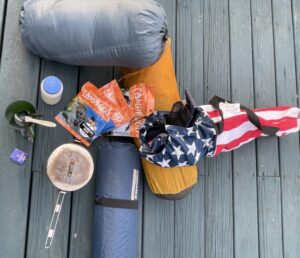
-
Looks like a lot! It’s not!
-

-
Essentials in box
The morning after our unplanned campout we woke well-rested, sipped instant coffee, packed up, found a breakfast cafe, and were soon back on the Interstate heading home.
A Note on Dried Food
Years ago, dried camping food was tolerable but hardly tasty. That’s changed. Modern foods are delicious. We keep two weeks of dried meals in our preparedness bin at home. Should we be impacted by a natural disaster we’d break out our camping stove and enjoy tasty meals. Although this food lasts for years we occasionally eat a few meals at home, on planned camping trips, and during emergencies. Then we restock with fresh meals. We have previously written about preparedness on our blogs.
by Winding Pathways | Jan 19, 2023 | (Sub)Urban Homesteading, Energy Efficiency, Home Improvements, Preparedness
Power outages. They happen in an instant. Most are only a flicker but some can last for hours when the wind’s whistling and the temperature’s dropping outside. Or in summer when the heat rises.
What’s the best thing to do in power outages? Well, it’s best to anticipate it and be ready by having a few things ready to pull out of the closet when the lights go out. Here’s a short list:
Cooking and Food:
- Propane or gas camping stove with plenty of fuel stored away from the main residence. (i.e. in a stand-alone garage) If you live in an apartment or condominium have less volatile fuel options ready.
- A few days of nonperishable or dehydrated camping food.
- Several gallons of water stored where it won’t freeze.
Power Outages and Light & Heat:
Electronics:
- Cell phones and other electronic batteries drain quickly. A backup power source and solar-powered phone charger keep the phone working.
One More Important Item:
- In a widespread power failure credit and debit cards don’t work. Cash always does. Keep some cash in small bills to use during emergencies.
Many other items readily available in case of emergencies help keep life comfortable. Read about them on our other blogs. The list above covers only the most basic and sometimes overlooked, emergency items to keep on hand. Get ready now for power outages.
-
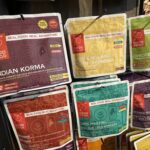
-
We found the meals tasty and filling.
-
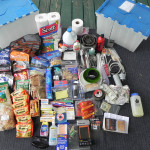
-
emergency food
-
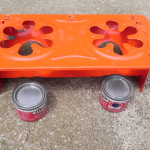
-
This two-burner Sterno keeps food warm but is less useful for cooking. Great for old style fondue parties!
by Marion Patterson | Jun 2, 2022 | Chickens, Garden/Yard, Geology/Weather, Hoover's Hatchery, Preparedness, Reflections/Profiles, Travel/Columns
Coming up to a year from the last post on the features we wrote for the Cedar Rapids Gazette, here is an updated list for the second half of 2021 and the first half (almost) of 2022. These features are in addition to our regular work with Hoover’s Hatchery blogs and FB Live and our own blogs for Winding Pathways.
May 8, 2022. Splish Splash! Whitewater Kayaking in Iowa. (No link to date)
April 22, 2022. Finding America On Roadways East.
April 13, 2022. Muscle Over motor When Boating.
March 21, 2022. Rockhounding.
January 30, 2022. Backpacking Bonus. (8B of GZ. No link to date) Available Green Gazette.
January 24, 2022. Distinctive Religious Structures.
January 16, 2022. Hiking Wild Areas. (no link to date) Available Green Gazette.
December, 2021. Country Schools. (no link to date) Available Green Gazette
November 15, 2021. Making a (Mini) Pitch for Soccer.
October 6, 2021. A visit with Midwest’s Pioneering Authors.
September 8, 2021. Taking a Slow Boat to Cassville.
September 6, 2021. Camping in Iowa’s Trout Country & Decorah’s Celebrities.
August 4, 2021. Parking While Headed East. And Solar Panels at Peoples.
by Winding Pathways | May 26, 2022 | (Sub)Urban Homesteading, Garden/Yard, Garden/Yard, Preparedness
Good Friday Tradition
On a cold April morning, we planted a row of potatoes at Winding Pathways. This plant has made an amazing long journey to reach our yard.
Potatoes are native to South and Central America and were cultivated by native people long before Columbus. Early Spanish explorers realized this humble American plant produces an enormous amount of food that’s easy to store. They brought potato sets back to Spain, and eventually, the plant was cultivated throughout Europe.
-
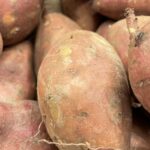
-
Sweet potatoes are a healthy vegetable.
-

-
Potatoes are hardy and plentiful.
Productive Crop
Potatoes produce more human food per square foot than wheat, rice, corn, or nearly any other crop, so crowded Ireland embraced the plant. Potatoes thrived in Irish soil and were so productive they enabled the human population to flourish. Unfortunately, the entire crop was of just one or two varieties. Disaster hit. Between 1855 and 1859 blight killed most of the crop, which lacked resistance to the disease. It caused massive starvation and spurred huge immigration to the United States.
Early Europeans who colonized North America brought potatoes to plant in the New World. So, an American plant crossed the Atlantic Ocean twice in its long journey.
Vandals and Hawkeyes
We both hold degrees from the University of Idaho. It’s the potato state, and the plant loves the light volcanic soil along the Snake River in the southern part of the state. Iowa, where we live, is the corn state, but humble potatoes do well in our garden.
We buy seed potatoes in early spring, cut and cure them, and plant them in early April. They don’t expect much from us, and by mid-summer we carefully hand dig delicious new potatoes. Later, when the tops die back, we dig and cure a bushel, or so, for winter storage.
Expert Resource at Hand
We hedge our bets by planting a few potato varieties, and this year we’re fortunate to have a potato expert move to Cedar Rapids. Jean Contina earned his doctorate degree from the University of Idaho studying potato diseases. He’s a fellow Vandal! We’ll seek his advice on how to maximize our crop.
-
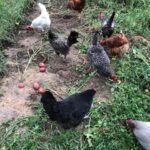
-
Chickens don’t seem to bother the potatoes.
-
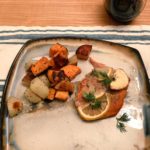
-
Beautifully presented dinner.
Inexpensive. Why Grow Them?
Store-bought potatoes are one of the least expensive foods. So why grow them?
We have two reasons. First, anything we grow seems more delicious than its store-bought counterpart. It may be our imagination but it is true. Second, they are an easy crop to grow and store well all winter without the need to can or freeze them. Having potatoes stored in a cool dark room in our house gives us a bit of food security in a crazy world.
